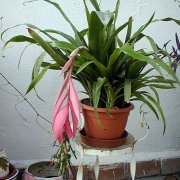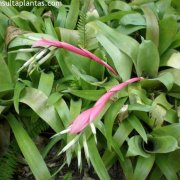Care of the indoor plant Billbergia nutans or Queen's tears |
|
The genus Billbergia, family Bromeliaceae, comprises 65 species of bromeliads native to South America, Mexico, and Central America. Some species are: Billbergia nutans, Billbergia pyramidalis, Billbergia zebrina, Billbergia saundersii, Billbergia amoena. Common name: Queen's tears. This species is native to to Brazil, Paraguay, Uruguay, and Argentina. They are terrestrial bromeliads (not epiphytes) with narrow olive green rosette leaves with silver sheen; they reach 50 cm (1.64 feet) in height. The flowers appear in hanging clusters with pink bracts; They are small and yellowish green with blue edges. They bloom in summer; young plants are able to flower. Queen's tears is used as indoor plants for their easy cultivation; in tropical and subtropical climates they are used to cover areas of the garden under trees or shrubs. Billbergia nutans requires illuminated exposure without receiving direct sunlight and temperatures never below 10 ºC (50 ºF). It is very important that the ambient humidity is high: spray the plant with lime-free water periodically or place a plate with wet stones under the pot. The ideal soil can be a substrate for houseplants with peat and leaf mulch. Water regularly, with lime-free water, in spring and summer; in autumn and winter you have to wait for the soil to dry out. Queen's tears can store water in the center of the rosette. Fertilize with mineral fertilizer every 15 days in spring and summer. Billbergia nutans is quite resistant; not to cold and low humidity that can cause aphids and mealybugs attacks. Queen's tears propagates by seeds but it is easier from the suckers that the plant produces (during spring). |
Images of the indoor plant Billbergia nutans or Queen's tears |
Find plants
Billbergia nutans or Queen's tears | Care and Growing
© 2026 FavThemes

